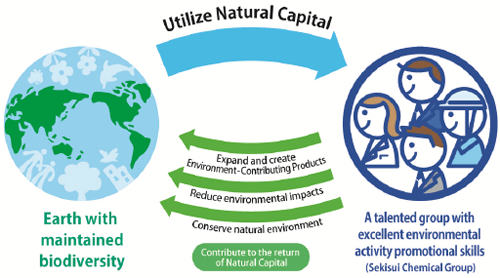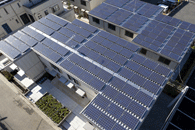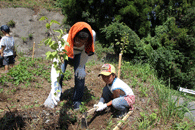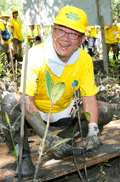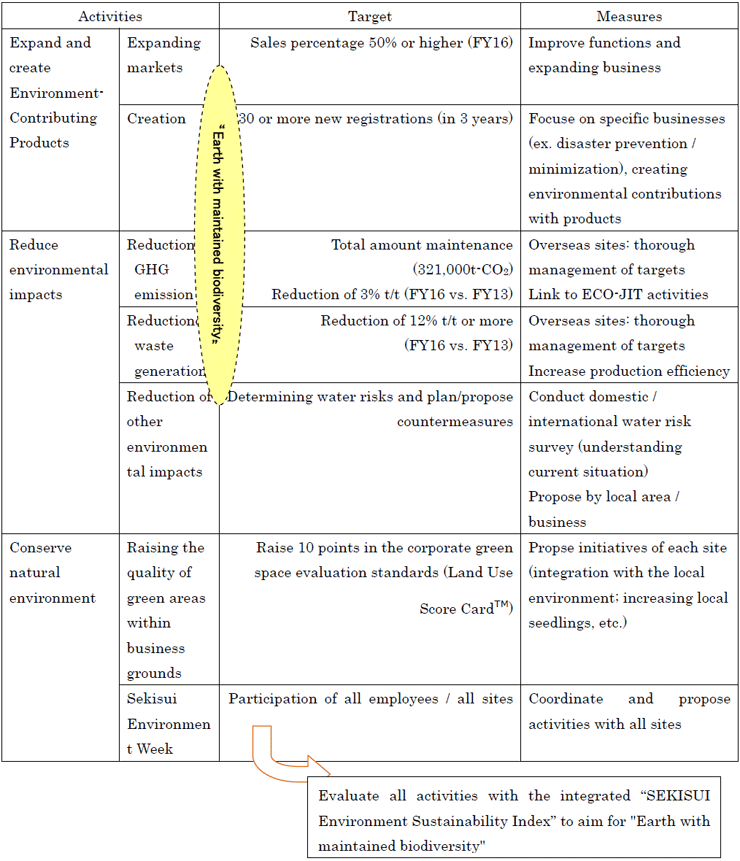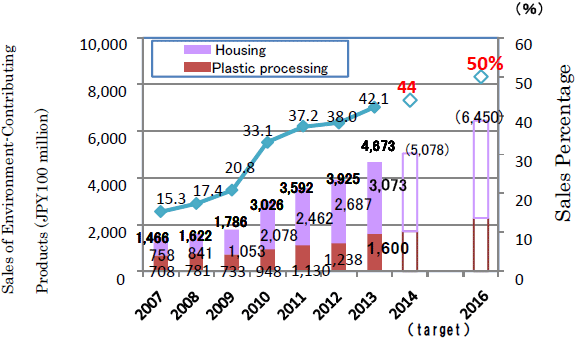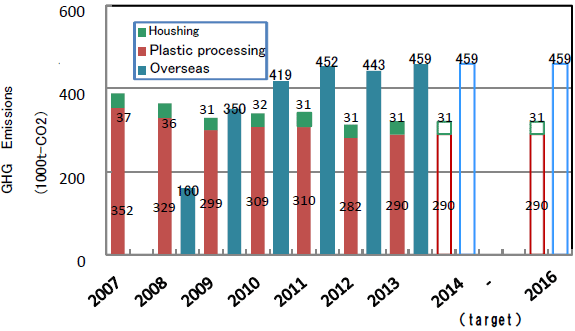|
■ |
Aim for sales percentage of environment-contributing products of 50% or more (FY2016) |
|
■ |
Evaluate comprehensive environmental activities by establishing a new integrated index to visualize contribution to the return of natural capital |
|
|
SEKISUI CHEMICAL CO., LTD. (President: Naofumi Negishi, hereinafter called
"Sekisui Chemical") and the Sekisui Chemical Group, under the five-year
environmental midterm plan "Environment Top Runner Plan SHINKA!" up
to FY2013, have promoted "SHINKA (evolution, deepening, renewing)"
aiming at balancing ecology and economy, expanding sales of Environment-Contributing
Products and reducing CO2 emissions generated by business operations and other
environmental efforts.
Recently, following the formulation of the company-wide new midterm management plan "SHINKA!-Advance 2016" (FY2014 - FY2016), we have revised our long-term environmental vision "SEKISUI Environment Sustainable Vision 2030" (hereinafter called the "Long-term Vision"), and will make efforts for a "Earth with maintained biodiversity" as a joint goal in all our businesses and operations, from housing to plastic processing.
|
To solve the remaining issues in the previous environmental midterm plan
(Table 1) and realizing our Long-term Vision, we formulated the new environmental
midterm plan "SEKISUI Environment Sustainable Plan Take-off" (FY2014
- FY2016).
The new environmental midterm plan is positioned as the first step (take-off) to realize our Long-term Vision, and we will work to further expand the sales percentage of Environment-Contributing Products.
1. Summary of the previous environmental midterm plan (FY2009 - FY2013)
Table 1: Issues remaining from Previous Environmental Midterm Plans
|
Activity item |
Target |
Results |
Issues |
|
|
Environment-Contributing Products |
|
Sales percentage: 40% or higher (FY13) |
Sales percentage: 42% |
Further expansion
|
|
|
30 or more new certifications (in 5 years) |
60 new certifications |
||
|
|
Reduction of 10% or more (FY13 vs. FY07) |
17.4% reduction (Total amount: 321,000t-CO2) |
Expand efforts to overseas / supply chain |
|
|
|
Reduction of 25% t/t*2 or more (vs. FY07) |
19.6% t/t reduction
|
Strengthen efforts, expand efforts to overseas |
|
|
Environment contributing activities |
Activities in all production sites |
Implementation in all production sites
|
Expand to all sites
|
|
Note 1: GHG: Green House Gas. Note 2: t/t: (‘ton per ton’ : per production unit)
Evaluation of all activities
|
(1) |
Target achieved activities: Environment-Contributing Products, reduction of GHG emission, environment contributing activities |
|
|
|
|
(2) |
Target unachieved activities: Reduction of waste generation |
Environment-Contributing Products
|
(1) |
Total registered products: 34 (end of FY2008) to 87 (end of FY2013) (7 de-registered during this period) |
||||||||||||||||||||||||
|
|||||||||||||||||||||||||
GHG emission reduction
|
Factors for achieving goals: Promotion of various measures such as the following |
|||
|
|
・Operation of in-company environmental investment promotion system, implementation of ECO-JIT* / energy innovation activities |
||
|
|
・Optimization of lighting, use of LEDs |
||
|
|
|
*ECO-JIT: |
Activity to reduce energy costs by thorough detection of energy losses in production processes and thorough innovation |
|
|
|||
Reducing waste
|
(1) |
Factors for not achieving goals: efforts at manufacturing sites
were not enough to achieve target |
|
|
|
|
|
|
|
(2) |
Challenges are to improve production efficiency from a new perspective and to strengthen efforts by expanding recycling, etc. |
|
|
Examples of efforts to reduce environmental impact
|
|
|||||||
Efforts to improve environmental awareness among employees
|
||||||
|
|
|
|||||
|
(1) “Sekisui Environment Week”: |
|
|||||
|
|
Over one week from August 1 to 7, the same period as the Global Children's Eco Summit (or one continuous week between June 1 and September 30) all employees (groups or individual) from all sites of the Sekisui Chemical Group participate in local eco activities Begun from FY2013. |
|||||
|
(2) “Greenest Person Award”: |
||||||
|
|
Award given to an employees or small group with a high level of environmental awareness, undertaking activities that contribute the most to the environment. The winner is decided by votes from all employees and children attending the Global Children's Eco Summit. Begun from FY2012 to raise awareness to environmental activities. |
|||||
|
|
|
|||||
2. Background / key points in developing the long-term vision and the environmental midterm plan
The Sekisui Chemical Group, in order to restrain global-scale environmental
issues such as the increase of GHG emissions, over-consumption of resources,
and increasing impacts on the ecosystem, has undertaken efforts to reduce GHG
emissions, recycle resources (recycle / reuse), reduce waste, manage chemical
substances, reduce VOC, and protect forests, to contribute to the building of
a low-carbon and a recycling-oriented society.
In our Long-term Vision
and the environmental midterm plan, based on the concept that all these environmental
impacts affect global biodiversity, activities to aim for "Earth with maintained
biodiversity" are implemented in business activities.
Under this
policy, overall activities will be evaluated with a new index, the “SEKISUI
Environment Sustainability Index”, which will be set up to comprehensively
analyze the use of naturally-occurring resources (natural capital) that we cannot
make ourselves (such as land, animals, plants, ores, and fuels) and the return
to these natural capital through the business and environmental activities of
the Sekisui Chemical Group.
3. Summary of the new environmental midterm plan (FY2014 - FY2016)
|
|
Expand and create Environment-Contributing Products
Under the new environmental midterm plan, we will create and expand markets so that the sales percentage of Environment-Contributing Products will be 50% or higher.
|
|
|
Trend in sales and sales percentage of Environment-Contributing Products |
|
(1) Measures for existing Environment-Contributing Products: |
|
|
|
Expand sales of houses with solar energy generation systems, improve functions /expand business of pipeline rehabilitation systems, etc. |
|
(2) Registering new Environment-Contributing Products: |
|
|
|
Actively create new products and systems in new environment-contributing categories for protecting biodiversity, preventing / minimizing disasters, etc. |
Reduction of GHG emission
Believing that it is urgent to promote reductions in our expanding number of overseas business sites the same way as in Japan, we have set the same goals for inside and outside Japan to reduce GHG emissions in our new environmental midterm plan.
|
|
|
Trends in greenhouse gas emissions during production |
Our goals we will promote are to maintain the FY2013 level of total emissions even with the increased production plan, or to reduce GHG emissions at 3% t/t over three years even with reduced production volume from FY2013.
Reduction of waste generation
For waste generation, as with GHG, it is urgent that we promote waste reduction overseas; by applying the effective measures used in Japan, expanding Zero Emission factories and so on, we will promote reduction of waste generated with the same goals for Japan and outside of Japan.
Reduction of other environmental impacts
We are determining (survey) water risks and promoting measures in operations in all our business sites both in Japan and overseas, with the aims of “preventing loss of business opportunities by determining water risks” and “preserving biodiversity by strengthening water quality management”.
Raising the quality of green areas within business grounds
Aiming to realize "Earth with maintained biodiversity", we are improving the quality of green areas in our business grounds to ensure that business sites are in harmony with the global environment. We are promoting efforts to gain 10 points or better in the Land Use Score CardTM, the evaluation standard for all sites in Japan.
|
|
* Land Use Score Card®: A tool for Sustainable Business Sites as developed by the Japan Business Initiative for Biodiversity (JBIB). Evaluation points are awarded on a 100 point maximum basis for contributions to biodiversity in land use for business sites, considering the size of green areas, management structures and so on. |
Sekisui Environment Week
We are proposing and promoting programs in which all employees can participate, by understainding activities at each business site. Our aim is for participation by all employees from all business sites by FY2016.
By consistently holding symbolic events overseas with participation from the president and other management executives, we will promote activities to raise environmental awareness among employees.
Integrated Index
Using our integrated index, the “SEKISUI Environment Sustainability Index”, we will visualize the progress of initiatives and degree of achievement.
The calculation framework covers CO2 and other environmental aspects other than CO2 (chemical substances, water risks, etc.) in the entire supply chain. By determining / inputting data with a negative impact on natural capital and data with contributing / positive effect, we will calculate an index showing the degree of contribution for returns to natural capital.
|
(1) |
Example of negative impact:raw materials volume, fuel / energy consumption, water usage, CO2 / VOC / air pollutant emissions, water turbidity emissions, waste generated, land use, CO2 emissions in the supply chain |
|
|
|
|
(2) |
Examples of contributing effect: contributions through Environment-Contributing Products (reducing CO2 emissions, reducing the impact of chemical substances, saving water, etc.), activities / donations related to protecting the natural environment |
|
|
The calculation for FY2013 will be the benchmark for setting goals from FY2014 onward. We aim to ensure our returns to natural capital will exceed our use of natural capital by the final year of our Long-term Vision, FY2030.
Disclaimer
This press release may contain forward-looking statements. Such forward-looking statements are based on current expectations and beliefs and are subject to a number of factors and uncertainties that could cause actual results to differ materially from those expressed or implied by such statements due to changes in global economic, business, competitive market and regulatory factors.

